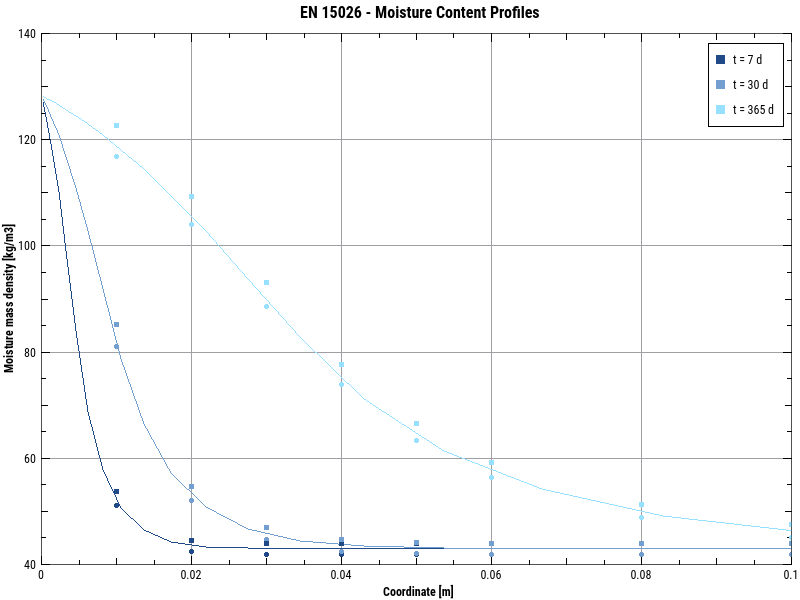The EN 15026 (2007), Annex A formulates a single test case for a 1D hygrothermal problem. This test case analyses the response of a semi-infinite material to a jump in boundary conditions. The hygric material properties are relatively simple (and unrealistic), just as the considered geometry. These simplifications are necessary for the analytical approximative solution. This reference solution is used to compare simulation results against.

Problem description
A single material layer, stretching infinitely into one direction, is assumed to be in equilibrium with the environment. At a given point in time (simulation start) the environmental conditions jump to different values. The test case requires computing the resulting changes in temperature and moisture distribution in the material.
- Initial conditions: temperature = 20°C, humidity = 50 % r.H.
- The environmental conditions jump to: temperature = 30°C, humidity = 95 % r.H.
- Surface transfer coefficients/resistances and other boundary conditions are not considered
Required results:
- moisture and temperature profiles past 7, 30 and 365 days
Reference solution and results
For this test case a quasi-analytical solution exists (parts of this solution are computed with numerical integration):
Claesson, J; Boltzmann solution of coupled nonlinear equations for moisture content w(s) and temperature t(s), s=x/root(4t). Benchmark Test I, CEN (2002).
The Annex A of the EN 15026(2007) standard lists the lower and upper bounds for reference values at given time points and coordinates. Unfortunately, an error was introduced when transfering numbers from the reference solution to the standard text. The 2.5 % maximum deviation from the reference solution was not correctly applied to compute the lower and upper bounds. Hence, it is generally not possible with numerical simulation programs to meet the limits imposed by the standard at all time points and coordinates.
NOTE: The updated EN 15026 standard (due 2022) contains a corrected list of reference values.
Evaluation of the usefulness/applicability of the test case
This test case evaluates only very basic functionality of hygrothermal building component simulation tools. Nearly all important model components, beginning with ambient climate and boundary conditions, to foils/vapor retarders, air flow, liquid/capillary transport in opposite direction to vapour diffusion flux, multi-layered constructions, moisture sources etc. are not evaluated. Hence, this standard is not suitable for ensuring quality of modern numerical simulation tools for hygrothermal simulation.
A validation using EN 15026 (2007) alone is therefore meaningless.
